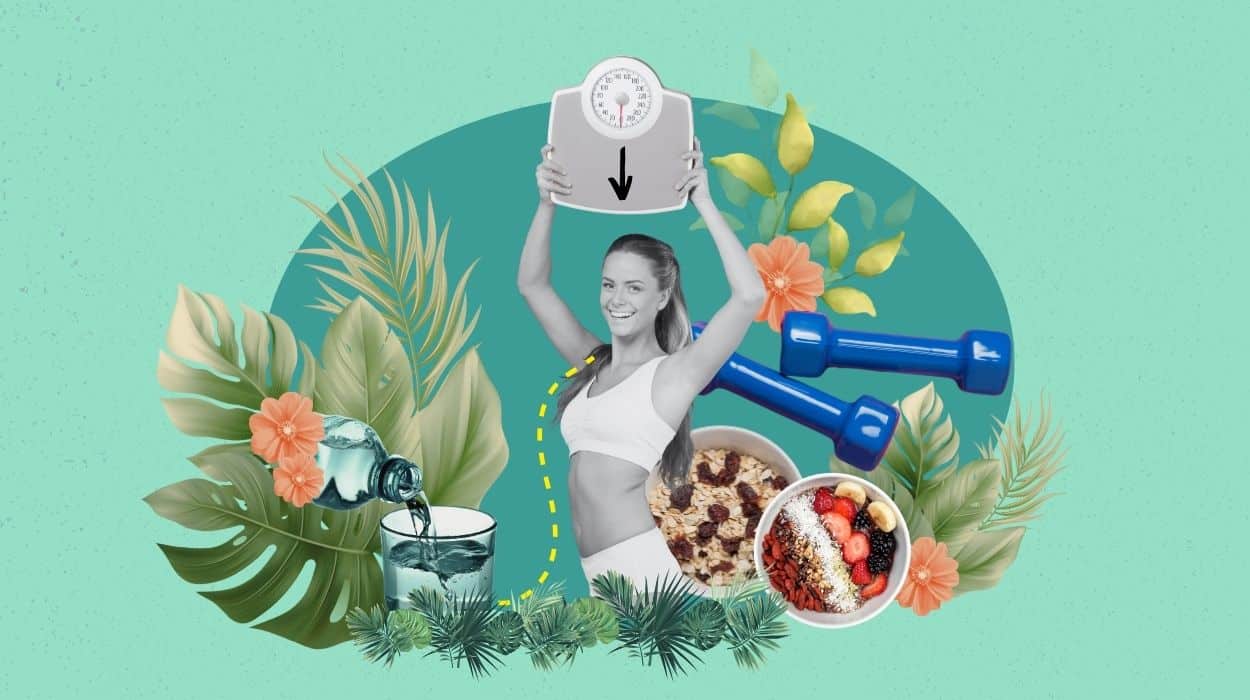If you’re working on losing weight in a month, you should know that, in addition to the exercise hormones, the new desire for fresh, healthy meals, and the general vibes you attract from taking care of yourself, another advantage is you’ll look and feel remarkably better.
Reaching your weight loss goals can be a big challenge regardless of how much weight you want to lose. People can reach a healthy weight in many different ways. However, taking it one step at a time and making a few modifications to your diet and lifestyle can make weight loss much more manageable.
How To Lose 10 Pounds In A Month?
- Keep Hydrated
- Exercise
- Calculate Your Macros
- Eat Slowly
- Add Fiber To Your Diet
- Prioritize Sleep And Minimize Stress
- Bring Your Hormones Back Into Balance
How To Lose 10 Pounds In A Month?
Try the following tips for safe, noticeable, and long-term weight loss.
Keep Hydrated
Lack of enough water intake, can cause a decrease in your metabolism, increase your BMI, and lead to obesity. Though a challenge for some, drinking enough water is one of the truest ways to lose 10 pounds in a month. Besides its zero calories, hydration supplies you with the required energy to build muscle and also drops your calorie consumption by feeling full.
Drinking a glass of water when waking in the morning and before each meal can help you feel more satisfied and consume fewer calories. To know how much water you should be drinking in a day, take your body weight, divide it in half, and drink that many ounces of water per day at a minimum. Depending on your activity level, you may need more.
Exercise
To lose 10 pounds in a month, you need to work out. Being regularly active not only helps to lose weight, but it also keeps it off. Anything that builds up some heat ( even causing you to sweat a bit) is best! A combination of aerobics (running, kickboxing, walking, biking, dancing, jumping rope, playing sports, rowing, and swimming) and high-intensity interval training (HIIT) is ideal.
According to the AHA, plan for at least 150 minutes[1] of moderate exercise that is spread over a 5-day work week, e.g., aerobic activities like brisk walking, swimming, mowing the lawn, cycling at 10 to 12 miles/ hour, vacuuming, tennis doubles, etc.). Alternatively, plan for 75 minutes of vigorous aerobic activities a week, e.g., hiking, tennis singles, aerobic dancing, jogging, or cycling at 12 – 14 miles/ hour.
With aerobic exercise, you are efficiently meeting your weight loss goals by burning more calories. It increases your heart rate and provides your muscles with the oxygen needed to keep moving. The strength and energy to keep your body moving come from the oxygen you create with exercise and the body fat, carbs, and protein your body stores. The more you utilize cardio exercises, the more success you may have at losing fat.
Calculate Your Macros
When you calculate macros (i.e., macronutrients), you ensure that what you consume is just as important as how much. To make it simple and less overwhelming, your macros are based on the following:
- Carbs: Carbs fuel energy, and 1 gram equals 4 calories
- Protein: Proteins build and repair muscle, and 1 gram equals 4 calories
- Fat: Fat keeps you satiated, and 1 gram equals 9 calories
When you count macros, what happens is you really are counting nutrient-dense food (protein, carbs, and healthy fats) instead of limiting your calorie intake but potentially eating the wrong thing. Calories are the energy your body releases when it breaks down food. If you eat more calories than you need, your body stores the excess as fat.
So to burn fat, you’ll need to eat fewer calories than you need[2] for your daily energy. This will cause your body to visit its storage shed fat for the energy you stored previously.
Eat Slowly
This is one way to lose weight safely without changing your eating habits. When you eat slowly, you give your body time to start digesting the food, release hormones, and send signals to your brain that you’re full. With this, you’ll prevent yourself from overeating. This process takes about 20 minutes, meaning you can overeat what you’re able to consume in those 20 minutes!
Also, studies show that by eating slowly, you decrease the amount of food consumed during a meal because you increase your fullness hormone.[3] In other words, if you eat quickly, you consume calories your body may not need.
Add Fiber To Your Diet

A nutrient you want to be sure you eat quite often is “fiber”. Numerous studies show diets high in fiber significantly affect how much weight you can lose. This is because fiber is a nutrient that stays intact and undigested as it passes through your digestive system, so your body doesn’t retain calories from fiber.
Adding healthy eating amounts of fiber[4] to your daily meals lets you feel fuller for longer and stabilizes blood sugar! It delays your cravings and keeps you feeling fuller[5] for longer.
According to a study, increasing your daily fiber by just 14 grams (without other changes to your diet) leads to a 10% decrease in calorie intake.[6]
Prioritize Sleep And Minimize Stress
Sleep is highly underrated for healthy weight loss. The amount of sleep a person gets may impact their weight since sleep deprivation[7] can lead to weight gain. According to a 2011 study,[8] less sleep can raise ghrelin levels, a hormone that increases appetite. Sleep deprivation can also lower leptin levels, causing you to feel less full, which can tempt you to increase your calorie intake.
Additionally, if you’re sleep-deprived, you are less likely to keep up with exercising, which immediately stunts your weight-loss efforts.
Bring Your Hormones Back Into Balance
Sometimes hormonal issues can also make losing weight extra difficult, especially in perimenopause or menopause.
Is It Possible To Lose 10 Pounds In A Month?
When we set weight loss goals, it is imperative that we remain realistic. While losing 10 pounds in a month is possible, it typically isn’t advisable. Nevertheless, you sure can achieve that by changing your diet routines away from sugary or processed foods and adjusting your lifestyle habits in general.
How Much Weight Can You Lose In A Month?
You can safely lose up to 10 pounds in just a month. While this will not be easy, it is doable if you commit.
According to the 2015-2020 Dietary Guidelines for Americans, in order to lose weight, people may need to reduce the number of calories they consume and increase their physical activity. This generally means weight loss is one and a half pounds a week; your daily calories need to be reduced by 500 to 750 calories (note that 1 pound of fat contains 3,500 calories).
By adopting relatively minor lifestyle changes (such as reducing that daily 20oz bottle of soda, which is 250 calories) and taking the 45-minute 2.5-mile walk daily (about 250 calories), it is possible to shed a couple of pounds with little difficulty.
How Many Calories That Help You Lose 10 Pounds In A Month?
Your calorie intake is something to work around with. While everyone’s caloric needs are different, for the average lady, aiming to eat around 1,600 calories per day will help you lose pounds.
How Long Does It Take To Lose 10 Pounds?
It depends on a lot of factors, such as age, sex, and starting weight. But on average, you should lose 10 pounds in exactly 5-6 weeks for a healthier and more achievable estimate. This means that you lose around 2 pounds per week, which is in line with the CDC’s recommendation for safe weight loss at a rate of 1–2 pounds per week,[9] a sustainable goal.
A few ways to start losing weight loss effectively and healthily are:
- Walking: A person of the average build could lose 150 calories daily if they walked for 3 miles as a daily routine. This deficit would allow you to shed around half a pound every two weeks, equating to about 2 pounds monthly. While this might not sound like the quickest way to drop your body mass index,[10] it is certainly one of the healthiest and requires minimal effort.
- Running: Running 3 miles daily could cause a 300-calorie deficit in a person of average build. This daily deficit could result in a loss of 1 pound each week, which is equal to around 4–5 pounds every month. And, if you consider that there are approximately 4 weeks in each month, you could lose 8–10 pounds in 8–10 weeks, which is in line with best practices for weight loss.
Is Working Out 30 Minutes A Day Enough To Lose Weight?
Exercising for 30 minutes a day can be very effective for losing weight, according to WebMD. Being active is important for any weight-loss program. When you’re active, your body uses more energy (calories). And when you burn calories more than you consume, the weight scale will quickly start going down.
Exercise is really important when you want to lose weight. According to the Office of Disease Presentation and Health Prevention, around 30 minutes of moderate activity five days a week will support weight loss (especially for beginners). It’s moderate, hence you don’t have to work yourself up in order to lose weight.
Stick To A Schedule
A way by which a person can attempt to lose weight is to set a monthly weight loss goal that is realistic and safe to achieve.
- Write your workout down (all the moves you need to do (in sets and reps if possible) and make sure that it is something you know to do with ease, so you are ready to get in there, do your workout, and maximize that time. If using a video, watch it the night before to give you an idea of what’s to come.
- Plan your workout by setting out your clothes and other gear.
Use Relaxation Techniques
Lack of sleep has been shown to derail weight loss efforts and increase your risk of obesity.
Switch Things Up
Repeating a routine can be hideously boring. Split up your days into different things to keep matters interesting and avoid overtraining one muscle group.
Eat On A Calorie Deficit
Calculate your calorie deficit to ensure that you eat fewer calories than your body requires. Always eat healthy meals.
Does Losing 10 Pounds Make A Difference In Appearance?

Sure, 10 pounds is a considerable weight to lose and will let you see considerable changes while looking in the mirror. You can drop a full clothing size by shedding 10 pounds! When you let off those excess pounds,[11] you might observe your cheeks to be a little slimmer, your cheekbones more defined, and your jawline a little more pronounced.
A study[12] found that a person of average height would need to lose around 9 pounds to notice any difference. Women tend to shed weight all over their bodies first while still holding on to weight in their thighs and hips. On the other hand, men usually lose pounds in their midriffs first.
But then again, a difference in appearance will also depend on your starting weight and where you tend to carry most of the fat in your body. The fat that melts from your body first is different for everyone, and it is possible to shed weight from the place you gained it last.
Why Is It So Hard To Lose 10 Pounds?
Losing 10 pounds can be challenging because making long-lasting lifestyle changes cannot be an easy feat. Things that will derail your goals of losing 10 pounds or more are:
- You are consuming a lot of added sugar: Most of the items locked away in your pantry have hidden sugars. This means you really must dig through what you should and should not buy on your weight loss journey for any progress to happen.
- You are hardly eating enough: When you deprive yourself of food, your body tends to cling to as many calories as it can because it’s trying to retain the nutrients it needs to survive.
- You are consuming a lot of salt: Salt retains water. So the more sodium you include in your food, the more likely the scale will tip the next day.
Safe Weight Loss
The USDA[13] suggests that a healthy weight loss routine should comprise the following:
- A reasonable and realistic goal for weight loss
- A nutritionally balanced eating plan with reduced calories
- Regular physical activity
- A behavior change plan that helps a person achieve their weight loss goals.
The American Heart Association[14] also recommends that a person sets realistic weight loss goals. Additionally, according to the CDC, a loss of 1–2 pound per week is a reasonable goal, and persons who lose 4–8 pound per month is more likely to keep the weight off. With that, a healthy eating meal and an exercise routine will need to be supported to maintain the weight loss rate of half a pound per week.
Conclusion
It might not appear like it, but shedding 10 pounds is definitely an achievable goal, although not easy. While it sometimes seems unfair, some people lose weight more easily than others.
The most important thing, however, is to focus on developing healthy habits and making small, consistent lifestyle changes. Before long, these habits will become second nature, and when they become part of your lifestyle, losing weight becomes part of your gain.
Frequently Asked Questions
Yes, it is possible if you adjust your lifestyle and dietary routines, which can easily be accomplished through more exercise and watching food intake.
Exercise not only burns calories, it also helps build muscle and reduce body fat. Muscle uses more energy than fat, meaning the more muscle you have on your body, the more calories your body will naturally burn.
To lose weight, it is recommended that you get about 150 minutes of moderate aerobic activity, 75 minutes of vigorous aerobic activity, or a combination of the two each week.
You should not lose more than 2 pounds weekly, and a 10-pound weight loss should, under ideal circumstances, take place over 10 weeks. Losing weight too quickly can also cause you to lose lean muscle tissue, making it significantly more challenging to maintain your weight loss and stay at your goal weight.
It absolutely is. If you give your all during that half hour, the scale will quickly drop.
A person of average height would need to lose around 9 pounds to notice the difference.
When losing weight in an effective, healthy, reasonable way, it should take around ten weeks to lose 10 pounds.
Each person’s calorie intake is very personal and needs to be experimented with.
 Expert's opinion
Expert's opinion
